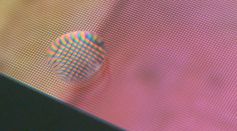Tags: Nanotechnology

Osteoarthritis Symptoms Can Be Alleviated Using Lubricants Inspired by Ice Solutions Found in Olympic Arenas

Structural Blueprint of Nanoparticles Targeting Blood Cells That Cause Lung Inflammation Developed

New Approach to Store Hydrogen Using ‘Nano-Chocolates’ Method Introduced

Martine Rothblatt Named 2021 Lifeboat Foundation Guardian Award Winner

Tiny Transistors Smaller Than Hair Strand Expected to Help Fabricate Nanoscale Electronic Devices

Nanotech in Medical Imaging, Security Screening; Researchers Reveal How Nanocomposite Works for ‘Picture-Perfect’ X-ray Scans
All-Optical Switching for Magnet Recording: A New Approach for More Efficient Nanoscale Magnetic Storage Devices

Soft Contact Lenses Loaded with Gold Nanoparticles; Researchers Develop Substitute for Laser Protection Glasses to Shield the Eyes
Smart Transformable Nanoparticles Developed to Diagnose, Treat Tumor; Study Reveals Devising of Biomedical Nanomaterial
Magic Wand-Like Tool Developed Using Nanomaterials; New Imaging Technology to Help with Next-Gen Electronics
Nanoparticles Within Life-Threatening Medications May Help Reduce Infusion Reactions
Quantum Simulation: How Does It Help Single Molecules Survive Different Temperatures, Stabilize Unique Nanostructure?

Cooler Than Cotton: Research Team Develops Modified Silk Cloth That Keeps Temperature Cool Even Under Direct Sunlight
Fluorescent Nanomaterials Given an Eco-Friendly ‘Glow Up’ in a New Study

Blue Phase Liquid Crystals Made Stable for Better Functions and New Optical Technologies
2D Boron Monosulfide Nanosheets: First Time for Researchers to Develop this Nanotech Mechanism for More Efficient Batteries, Electronic Devices

Nanocrystal-Glass Composites: Researchers Develop New Innovation That Can Produce ‘Unbreakable’ Screen in Devices
Thermoelectric Devices Used to Apply New Approach That Controls Heat Flow, Generates Electricity at Nanoscale
Nanotwinned Titanium: New Nanotech Approach for More Sustainable Manufacturing, Simpler Atom Movement
Nanoscale Structures Develop New Metasurfaces Called ‘Metalens’ That Use Narrow Holes Instead of Tall Pillars
Most Popular

Microplastics Are Everywhere — How Plastic Pollution Threatens Wildlife, Soil, and Water

Brain Health Aging Guide: Effective Strategies for Cognitive Decline Prevention and Lower Dementia Risk

Mitochondrial Health and Aging: How Cell Energy Drives Modern Anti-Aging Science

How Scientists Use Radio Telescopes to Search for Alien Signals Across the Universe





